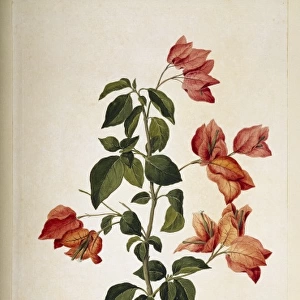Home > South America > Brazil > Related Images
Tetrapterys phlomoides
![]()

Wall Art and Photo Gifts from Mary Evans Picture Library
Tetrapterys phlomoides
Finished watercolour by Sydney Parkinson made during Captain James Cooks first voyage across the Pacific, 1768-1771. Illustration annotated Banisteria fulgens
Mary Evans Picture Library makes available wonderful images created for people to enjoy over the centuries
Media ID 8579573
© Mary Evans Picture Library 2015 - https://copyrighthub.org/s0/hub1/creation/maryevans/MaryEvansPictureID/10706460
18th Century Brazil Captain Cook Captain James Cook Cook Endeavour Eudicot Eurosid Fabidae First Malpighiales Rosid South America South American Sydney Parkinson Angiospermae Dicot Dicotyledon Magnoliophyta Malpighiaceae
EDITORS COMMENTS
This stunning watercolour painting, created by Sydney Parkinson during Captain James Cook's first voyage across the Pacific Ocean between 1768 and 1771, showcases two intriguing South American plant species: Tetrapterys phlomoides and Banisteria fulgens. The illustration, annotated with the names Banisteria fulgens and Tetrapterys phlomoides, offers a glimpse into the natural wonders that captured the imagination of the crew aboard the HMS Endeavour. Tetrapterys phlomoides, also known as the four-leaved tree, is a small shrub or tree belonging to the Malpighiaceae family, order Malpighiales, and class Eudicot. Its leaves, as the name suggests, have four lobes, and its white, tubular flowers bloom in clusters. The plant is native to South America and is characterized by its attractive, bright red bark. Banisteria fulgens, commonly known as the Caapi vine, is a woody vine from the same family and order as Tetrapterys phlomoides. It is a significant plant in the traditional practices of various indigenous cultures in South America, particularly in the preparation of Ayahuasca, a sacred brew used for spiritual and healing purposes. The vine's flowers are small, white, and tubular, and it produces large, fleshy, red fruits. Sydney Parkinson's meticulous watercolour painting not only serves as a beautiful representation of these two fascinating plants but also provides an essential historical record of their appearance during the 18th century. The painting's annotation with the correct botanical names demonstrates Parkinson's expertise and accuracy in documenting the natural world, making it an invaluable resource for botanical and historical research.
MADE IN THE USA
Safe Shipping with 30 Day Money Back Guarantee
FREE PERSONALISATION*
We are proud to offer a range of customisation features including Personalised Captions, Color Filters and Picture Zoom Tools
SECURE PAYMENTS
We happily accept a wide range of payment options so you can pay for the things you need in the way that is most convenient for you
* Options may vary by product and licensing agreement. Zoomed Pictures can be adjusted in the Cart.







